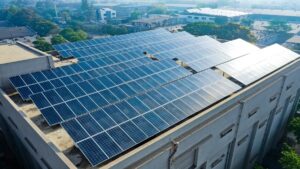
One of the most frequently asked questions pertains to the process by which solar panels harness sunlight and convert it into readily usable AC electricity on-site. A typical solar photovoltaic (PV) system consists of various key elements: solar panels, an inverter, a meter, and your pre-existing consumer unit. This guide aims to provide a clear and concise understanding of how solar panels function, complete with informative diagrams and a step-by-step elucidation. You can now unlock the power of clean, sustainable energy with Goldi Solar, your premier solar panel supplier in India. So why wait? Do visit us today.
What is Solar Energy?
The Sun’s radiant emissions are the source of solar energy, which is abundantly available to our globe every day. This renewable energy is enough to power every home on Earth, not just those in the United States. This demonstrates the tremendous potential of this clean energy source. While solar energy can be captured in a variety of ways, photovoltaic (PV) solar panels which convert solar radiation into electrical power are the most widely used technology. Goldi Solar is a trailblazing proponent of clean energy and is adamant about the critical role that solar energy can and should play in the global transition away from fossil fuels and traditional power generation. Our goal is to raise public knowledge of this vital energy technology so that we can harness the energy of the Sun.
Step 1: Solar Panels Capture Solar Energy
To begin, let us address the subject of how solar energy is produced. Solar energy is captured by solar panels and transformed into electrical energy for your house. One of three semiconductors is used to make the most popular solar panels: thin-film solar cells, polycrystalline silicon, or monocrystalline silicon. Electrons from silicon atoms are released when sunlight strikes the thin layer of semiconductive material. The positively charged side of the cell then attracts the negatively charged electrons. The free-flowing electrons inside the solar panel are what cause this “photovoltaic effect.” The wiring that is attached to the solar panels uses the electric current that is created by the moving electrons to generate power. The solar panels produce more electricity the more sunshine that strikes them. Your solar array’s panels receive the highest concentration of sunlight during peak sun hours, which enables them to convert sunlight into the greatest quantity of power during that time.
Step 2: Solar Inverters Convert DC to AC
We go deeper into the function of inverters as we continue our investigation of “How does solar energy work?” Direct current (DC) is the electricity produced by solar panels. It only goes in one direction. On the other hand, alternating current (AC), in which electricity oscillates, powers domestic equipment. As such, in order for the solar energy produced by your panels to be utilized within your house, it needs to be converted from DC to AC. This crucial task requires the use of an inverter. Although simple, the procedure is essential for utilizing solar energy. Your system can generate electricity without an inverter, but it won’t be able to power anything.
The size and configuration of your home’s solar energy system determine which inverter is best. A string inverter, a single device positioned in the centre of your circuit breaker, is usually used in a more basic setup. Microinverters are used in more sophisticated systems, where each panel has a separate inverter. Other inverter choices include hybrid and power optimizers, which are selected in accordance with the unique energy needs of your house. Apart from their main purpose, solar inverters also allow you to link your solar power system to the internet. You can obtain information about the functionality of your machine thanks to this link. You can keep an eye on the system’s performance and make sure it can supply enough electricity for your needs by comparing the amount of solar energy you produce with the amount of energy used in your home.
Step 3: Electrical Panel Distributes Electricity
The main hub for delivering electricity throughout your house is the electrical panel. By using circuit breakers to stop the flow of electricity in the event of a fault or surge, it plays a critical function in protecting your electrical system from potential overloads that could harm your electrical connections. Your appliances and other electrical gadgets are not directly connected to your solar panels, even though they are the source of the electricity. It’s crucial to realize that solar panels power your electrical panel in order to comprehend how they operate. This solar-generated power is then divided into separate circuits by your electrical panel, which supplies energy to all the different parts of your home. Additionally, electrical panels are a big part of keeping an eye on how much energy you use. You can attach more gadgets to the main panel or particular circuits to obtain more in-depth information about how much energy you use specifically. Over time, you can use this data as a useful tool to optimize your energy use patterns.
Step 4: Electric Meter Records Consumption and Production
Your utility provider uses an instrument called an electric meter, sometimes referred to as a “utility meter,” to measure how much electricity you use and use that information to calculate your monthly bill. Conventional electric meters have analog dials that turn when electricity passes through them. As a result, utility employees must periodically take readings of your meters in person to get an overview of your monthly consumption. By switching to solar power, you can minimize your dependency on the grid by beginning to use the electricity produced by your solar panels. This causes your electric meter to show a considerable decrease in electricity, which lowers your bill for electricity from the utility and saves you money.
Many homes with solar panels installed also have smart meters, which accurately track how much electricity is used in your home. Your local utility provider receives real-time usage data from smart meters for a number of uses, including billing, customer support, and research. This technology provides an accurate measurement of your electricity usage, therefore it does away with the need for projected bills.
Step 5: Batteries Store Excess Energy
Adding solar battery storage to your system is essential if you want to maximize the long-term benefits of switching to solar power. A solar battery is useful when the energy produced by your solar panels is more than you need right away. Without depending on the conventional electrical system, it enables you to effectively store that extra electricity and guarantee that you have a ready supply of power during times when the sun isn’t shining, like at night or in bad weather. There are different kinds of solar batteries; some are made to hold the extra DC power produced by your panels, while others are set up to be charged with AC power that has already been transformed by your inverter.
Join the solar revolution with Goldi Solar, your trusted partner for the finest solar panels in India. Harness the power of the sun to drive a greener, more sustainable future. Contact us today to explore our premium solar solutions and take the first step towards a brighter, eco-friendly tomorrow. Let’s power your world with Goldi Solar.



